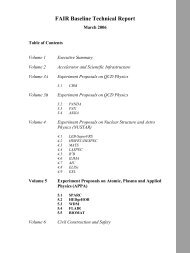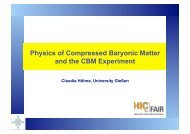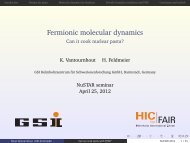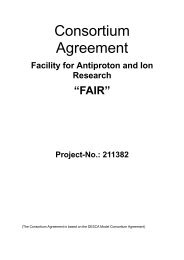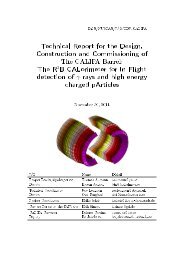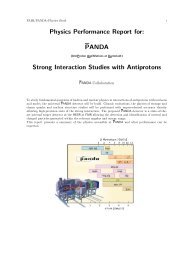NeuLAND - FAIR
NeuLAND - FAIR
NeuLAND - FAIR
You also want an ePaper? Increase the reach of your titles
YUMPU automatically turns print PDFs into web optimized ePapers that Google loves.
counts<br />
5<br />
10<br />
4<br />
10<br />
3<br />
10<br />
2<br />
10<br />
10<br />
LAND standard<br />
LAND - zero time res.<br />
10 cm plastic bars - zero time res.<br />
1<br />
-2 -1.5 -1 -0.5 0 0.5 1<br />
∆t<br />
(ns)<br />
Figure 4.7.: Effect of passive detector material on the time resolution from a GEANT3<br />
simulation of 470 MeV neutrons for three different detector configurations.<br />
For ∆t the time of first detected light was subtracted from the time of the<br />
first interaction.<br />
4.2. From a Passive Converter to a Fully-Active Scintillator<br />
Concept<br />
The reason for the use of dense, passive converters, as technically realized for LAND<br />
[Bla-92] by iron layers, has been, to improve the neutron efficiency via the detection<br />
of particles created in the converter material. The passive material has an enhanced<br />
interaction probability due to its higher density in comparison to scintillators. The active<br />
scintillator layers combined with the passive converters serve to detect the interaction<br />
products, mostly protons and γ-rays. In the following, we detail the difference in response<br />
for a fully active detector and for a converter-based detector (LAND, 5 mm iron converter<br />
layers) with respect to the achievable time resolution and to the efficiency. For a more<br />
detailed description of LAND we refer to section 4.1.2 and [Bla-92].<br />
A typical interaction of a high energy neutron with the iron converter leads to the production<br />
of several protons, secondary neutrons and gammas. Since the protons mainly<br />
come from evaporation of excited iron nuclei the angular distribution is isotropic and<br />
typical proton energies are a few MeV with a high-energy tail. Therefore, the time resolution<br />
is limited by the time jitter introduced by the protons traveling through the iron<br />
until reaching the active part of the detector. The secondary neutrons from the primary<br />
interaction have to pass part of the detector until they transfer energy to protons via<br />
elastic scattering in the scintillator material. Again a time delay is introduced.<br />
43





